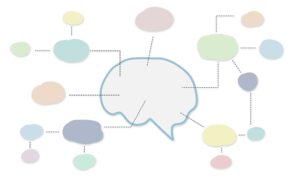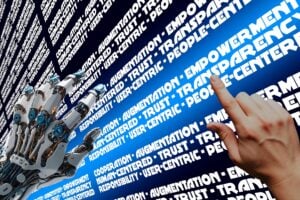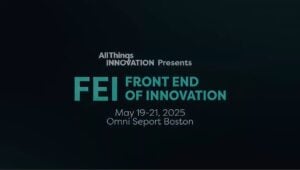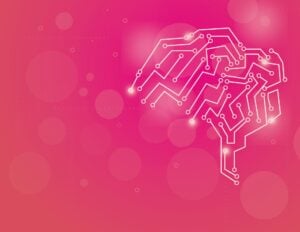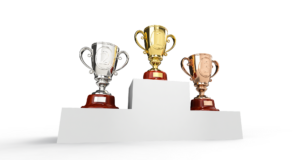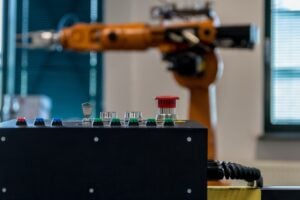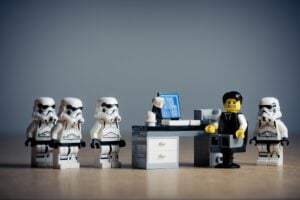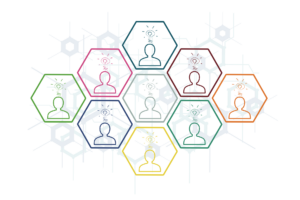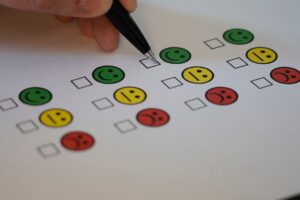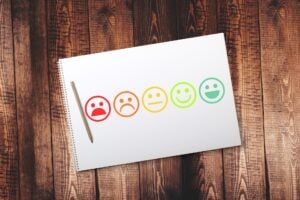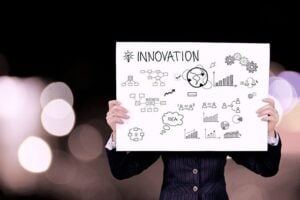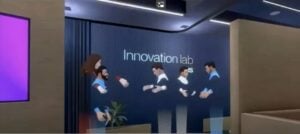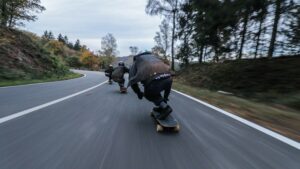KEY QUOTES
- “If we follow the rules we have today, we’re not ready for tomorrow. So we need to find where that space is… Where are those gray spaces that we can really push and challenge some assumptions and make a difference in the world with the work that we do.”
- “If leading change is about saying, ‘I have a vision, follow me to the future,’ then leading innovation is about how do I create an environment in which people will be willing and able to co-create the future with me.”
- “Innovation has to be a profit center. There’s no excuse. And to do this, you need to be systematic about incubation, because incubation is where everything happens, when you are turning ideas into proof of value.”
- “Technology for the sake of technology doesn’t do anything for anyone. If I’m being very candid, this is one of the big things that Web3 screwed up. It was a lot of like cool tech that solved no needs for anybody and therefore nobody used it.”
- “The real magic happens only when AI and the human brain work together, and they work at the right places.”
FULL SESSION SUMMARY
Day 1: Human Intelligence Day
FEI25’s Human Intelligence Day provided a comprehensive exploration of how human-centric approaches, strategic alignment, and organizational resilience are paramount for driving innovation and securing future growth. The sessions highlighted that successful innovation extends beyond technological prowess, emphasizing a deep understanding of human behavior. The “Actioning The Rogue Mindset” keynote and roundtable focused on the unconventional approaches required for breakthrough innovation, urging attendees to challenge existing rules and assumptions to find “gray spaces” for differentiation. Key themes included the power of cross-functional collaboration, fostering psychological safety for dissenting voices, and seeking inspiration from outside one’s immediate industry. Decision-making in innovation contexts was discussed as a balance of data and intuition, reframing failure as a learning opportunity.
The “FEI Honors” event paid tribute to innovation leaders like Linda Hill and Rita McGrath, who underscored a shift in innovation leadership from a vision-driven approach to one that fosters an environment for co-creation. Linda Hill emphasized creating psychological safety and embracing “disciplined deviance,” while Rita McGrath focused on strategic agility and continuous learning. Steve Blank advocated for a “two-speed organization” where innovation “future bets” are nurtured separately from core business operations.
The “Strategy & Transformation Track” explored the critical link between innovation and business success, moving beyond traditional product development to encompass broader strategic transformation. A central tenet was radical consumer-centricity, ensuring every innovation addresses a genuine consumer need aligned with business strategy. The track emphasized the power of emotional design and compelling storytelling in creating differentiated experiences. It also advocated for a “two-track innovation system” to manage both sustaining and disruptive innovations.
The “Innovation Excellence & Best Practices Track” focused on refining innovation processes by integrating advanced tools and fostering human-centered approaches. A key insight was that while AI can accelerate discovery, genuine human insights are crucial to prevent “model collapse,” where AI only reinforces existing patterns. Speakers emphasized the high failure rate of R&D and the need for inclusive design principles, incorporating diverse user perspectives from the outset..
The “Innovation Integration & Value Creation Track” underscored the necessity of systematically integrating innovation into the business, moving from mere ideation to predictable value creation. A core message was that “innovation has to be a profit center,” requiring a systematic approach to incubation where ideas are rigorously tested for proof of value. This track explored the transformative power of AI across the innovation funnel, emphasizing its role in mediating human labor, automating tasks, and fragmenting work. It also highlighted the importance of talent, emphasizing the need for HR to focus on cognitive traits like curiosity and problem-solving ability over pure knowledge.
Day 2: Artificial Intelligence Day
FEI25’s Artificial Intelligence Day explored the transformative power of AI in innovation, emphasizing that its true potential is realized through strategic integration with human intelligence and rigorous, data-driven approaches. The morning plenaries distinguished between “artificial intelligence” and “amplified intelligence,” advocating for a human-in-the-loop approach where human expertise guides and empowers AI. A central theme was that AI must solve real business problems and create tangible value, rather than being technology for technology’s sake. Challenges in scaling AI within large organizations were addressed, including the need for significant upfront investment in data protection, security, and continuous monitoring for “model drift. Leaders were urged to bridge a “management blind spot” by understanding AI’s exponential pace and fostering a culture of experimentation and risk-taking.
The “Collective Intelligence Startup Competition” showcased innovative startups leveraging AI combined with human intelligence to solve diverse business challenges. Key takeaways included the importance of strong foundational data, the ability of AI to scale human expertise, and the necessity of combining deep domain knowledge with technological innovation.
The “AI, Data, Analytics & Insights Track” emphasized the foundational role of data and analytics in driving successful AI-powered innovation. Trust in data partnerships, built through quality, strategic alignment, and data literacy, was a recurring theme. The track explored the challenges of scaling AI beyond initial proof-of-concepts, highlighting the “in-between moment” where companies must invest in transformational AI to avoid falling behind. Analytics was presented as essential across the entire innovation lifecycle.
The “R&D, Product Development, Experience & Design Track” explored how R&D and product development are transforming to align innovation directly with business strategy and drive revenue. Sessions stressed that innovation is no longer a cost center but a performance function, demanding measurable financial impact. The strategic integration of AI was a key topic, positioning AI as a “thinking partner” to expand perspectives. The importance of radical consumer empathy was highlighted, asserting that consumers buy experiences and feelings, not just products.
The “Future Trends to Customer 2030 Track” focused on de-risking innovation and cultivating sustainable growth by engaging with future trends and customer needs. Sessions covered novel approaches to market validation, such as “skin in the game” platforms where customers pre-commit to concepts. The strategic value of co-development with startups for accelerated R&D was highlighted, along with the importance of market fluidity and strategic partnerships. The track also explored leveraging AI for deep consumer insights and transforming industrial waste into profitable products.
Day 3: Collective Intelligence Day
FEI25’s “Collective Intelligence Day” explored diverse frontiers of innovation, emphasizing how strategic collaboration and foresight can drive business model transformation and sustainable growth. The “Solving Real Business Challenges with Collective Intelligence (HI+AI) Workshop” explored the synergy between human intelligence (HI) and artificial intelligence (AI) as collaborative partners. The core message was that true innovation “magic” happens when humans maintain critical thinking and strategic direction while leveraging AI for perspective expansion and efficiency.
The “Transformative Strategic Thinking: The Art of Disciplined Business Creativity Workshop” introduced a framework for challenging deeply held assumptions and reimagining business models in response to disruption. This session emphasized that transforming a business model requires disciplined creativity—a blend of fresh ideas, counterintuitive perspectives, and new points of view.
The workshop, “Silent Collaboration: Challenging Habitual Thinking, Constraints & Inefficiencies,” focused on fostering collaborative innovation, particularly highlighting the surprising effectiveness of working with strangers. Participants engaged in hands-on activities, and the hosts emphasized that collaborating with individuals unknown to each other often removes established power dynamics and preconceived notions, leading to more equal participation and breakthrough ideas.
The “Business Model Innovation: The Advanced and Urban Personal Air Travel Ecosystem” session explored the burgeoning flying vehicle industry as a rapidly developing ecosystem poised to transform urban mobility and logistics. Projections estimate this industry could reach $3 trillion by 2035, with a significant focus on sustainability benefits. The “Business Model Innovation: Space Economy Ecosystem” session provided a deep dive into the rapidly expanding space economy, projected to reach $1.8 trillion by 2035. Panelists discussed challenges like space debris and the need for international governance, highlighting NASA’s openness to collaboration.
Finally, the “Unpacking Quantum For Innovation and Your Organization” session demystified quantum computing, explaining its fundamentals, current state, and critical business implications. Nokia’s Leslie Shannon stressed the immediate and critical security implications, particularly the “harvest now, decrypt later” threat, urging organizations to explore quantum-resistant encryption solutions now.
KEY TAKEAWAYS
- Innovation Requires a “Rogue Mindset”: True innovation necessitates challenging existing assumptions, seeking “gray spaces” beyond conventional rules, and fostering psychological safety for dissenting voices and diverse perspectives.
- Human-AI Synergy is Paramount: The most effective innovation results from intentional collaboration between human intelligence and AI, with humans providing critical thinking and strategic direction, and AI expanding perspectives and enhancing efficiency.
- Innovation Must Be a Profit Center: Organizations must shift their mindset from viewing innovation as a cost center to a performance function, explicitly linking all innovation activities to revenue generation and ensuring measurable business impact.
- Radical Consumer-Centricity is Non-Negotiable: Every innovation must address a validated consumer need or intention, deeply understanding the emotional and experiential aspects of consumer desires to create truly differentiated and impactful products and services.
- Emerging Technologies Demand Proactive Engagement: Industries like urban air mobility, the space economy, and quantum computing, while still evolving, offer significant future growth opportunities and require organizations to proactively monitor, analyze, and strategically engage with their development.
DELIVERY ON EVENT FOCUS: Aligning Innovation with Business Strategy
FEI25 robustly delivered on the focus of aligning innovation with business strategy through several key areas. The conference consistently emphasized the financial imperative of innovation, positioning it explicitly as a “profit center” and a “performance function” that must be directly linked to revenue growth and measurable ROI. Sessions highlighted the need for problem-centric AI deployment, ensuring that AI implementations are strategically aligned with core business challenges and desired outcomes rather than being technology for technology’s sake. Strategic foresight and opportunity identification were central, with discussions on future trends like quantum computing, urban air travel, and the space economy directly addressing how to strategically position organizations for future growth by identifying emerging markets and mitigating long-term risks. The importance of data-driven decision-making was underscored, with analytics and data quality presented as non-negotiable for informed strategic decisions throughout the innovation lifecycle.
Furthermore, the event stressed the strategic imperative of organizational resilience through business model innovation, adapting to AI’s exponential pace and transforming business models for competitive advantage. Finally, talent and ecosystem development were highlighted as strategic investments in continuous innovation, emphasizing the empowerment of employees as “AI teachers” and the cultivation of external partnerships.
DELIVERY ON EVENT THEME: Harvesting Innovation and Sowing the Seeds of Future Growth
The Human Intelligence Day effectively addressed the theme of “harvesting innovation and sowing the seeds of future growth” through a multifaceted approach. Harvesting innovation was exemplified by the emphasis on innovation as a “profit center” and the systematic incubation processes aimed at yielding tangible business value from ideas. Discussions also focused on optimizing existing processes through “rogue mindsets” and improved internal collaboration to efficiently harvest ideas from current resources. The event highlighted learning from past successes and failures to refine future strategies.
Sowing the seeds of future growth involved cultivating a culture of innovation that fosters psychological safety, co-creation, and risk-taking. Strategic investment in talent and capabilities, such as hiring for cognitive skills and developing internal collaboration, was presented as sowing seeds for a future-ready workforce. The focus on long-term portfolio thinking, including “future bets,” clearly aimed at planting seeds for sustainable growth. Proactive consumer empathy and the ethical integration of AI, ensuring continuous human data input, were also discussed as vital for anticipating future market demands and supporting long-term, human-led innovation.
ACTION ITEMS FOR INNOVATION EXPERTS & CORPORATE CHANGEMAKERS
To action the learnings from FEI25, innovation experts and corporate changemakers should:
- Cultivate a “Rogue” Culture: Regularly schedule “assumption-busting” sessions to challenge deeply held beliefs. Implement practices that foster psychological safety for diverse opinions and critiques, such as anonymous feedback or dedicated “dissenting voice” roles. Create mechanisms for cross-industry learning, bringing in external speakers or consultants to spark new ideas and challenge internal echo chambers.
- Transform Innovation Leadership to Enable Co-Creation: Redefine leadership roles from sole visionaries to “environment builders” who empower teams to co-create solutions. Invest in learning agility by encouraging rapid experimentation and learning from “valuable failures,” integrating reflection and adaptation into every project lifecycle. Build ecosystems by actively engaging with external partners like startups, academia, and non-profits to expand innovation reach.
- Implement Radical Consumer-Centricity: Conduct qualitative research (e.g., ethnographic studies, direct observation) to deeply understand consumers’ emotional needs and pain points. Ensure every innovation concept explicitly addresses a validated consumer need and aligns with your organization’s business strategy. Prioritize the emotional and experiential aspects of products/services, mapping the entire customer journey for differentiation.
- Structure for Dual Innovation: Establish distinct organizational structures, funding models, and metrics for managing core business extensions (sustaining innovation) and speculative, high-potential ventures (disruptive innovation). Safeguard emerging innovations from the short-term pressures and established processes of the core business.
- Systematize Innovation Incubation and Value Creation: Implement rigorous incubation processes that focus on generating measurable proof of value for every idea. Ensure R&D, marketing, legal, and other critical functions are involved from the earliest stages of ideation. Develop comprehensive metrics that track both immediate impact and long-term value, moving beyond simple launch success to sustained growth and profitability.
- Evolve Talent Strategy for Innovation: When recruiting for innovation roles, prioritize cognitive traits like curiosity, critical thinking, problem-solving ability, and adaptability over specific industry knowledge. Invest in training that fosters cross-functional collaboration, design thinking, and the ability to navigate uncertainty within your existing workforce.
- Develop a Problem-First AI Strategy: Before implementing any AI solution, clearly define the specific business problem it will solve and the desired measurable outcomes. Conduct an “AI opportunity audit” to identify high-impact areas where AI can act as a “cognitive amplifier” for human teams.
- Invest in AI Infrastructure, Data Quality, and Ethics: Advocate for significant upfront investment in robust data governance, data quality frameworks, and cybersecurity measures to support AI initiatives. Establish “human-in-the-loop” processes for critical AI applications, including continuous monitoring for “model drift” and bias. Develop an ethical AI framework, ensuring transparency, accountability, and fairness in your AI systems.
- Bridge the “Management Blind Spot” and Foster AI Literacy: Educate senior leadership on the exponential pace of AI evolution and its strategic implications. Implement internal training programs that empower employees with “first principles” thinking and prompt engineering skills. Encourage grassroots experimentation with AI tools to build organizational confidence.
- Embrace Hybrid Human-AI Innovation Processes: Design innovation sprints that explicitly combine AI-generated insights with human creativity, tracking the success of hybrid ideas. Integrate real-time, behavioral insights into your front-end innovation process to validate concepts and reduce the “say-do gap.” Shift innovation metrics to prioritize “sticky innovation” and long-term value creation.
- Cultivate a Future-Focused Innovation Portfolio: Establish a dedicated strategic foresight function to monitor emerging technologies (e.g., quantum computing, urban air mobility, space economy) and assess their potential impact. Develop a phased roadmap for engaging with these future trends, including early research, partnership exploration, and pilot projects for long-term positioning. Proactively address long-term security threats, such as “harvest now, decrypt later,” by initiating research and implementation of quantum-resistant encryption.
- Implement Hybrid Human-AI Collaboration: Audit current innovation processes to identify specific stages where AI can enhance, rather than replace, human creativity. Train teams on structured AI prompting techniques (e.g., Five Lenses) and encourage collaborative dialogue with AI. Establish clear validation protocols for AI-generated insights.
- Drive Disciplined Business Model Transformation: Form cross-functional “transformation teams” tasked with applying the five transformational practices (shaping meaning, stretching experiential performance, sharing resources, switching roles, swapping value equations) to your organization’s core business model. Conduct regular “assumption-challenging” workshops to identify beliefs hindering innovation.
- Foster Collaborative Innovation Beyond Silos: Create “power-neutral” collaboration spaces or workshops where traditional hierarchies are temporarily suspended. Implement “stretcher sessions” where external or unfamiliar individuals review and critique ideas. Actively seek out opportunities for collaboration with diverse external partners.
- Develop a Strategic Foresight Framework for Emerging Technologies: For urban air mobility and the space economy, identify potential partnership opportunities and assess supply chain implications. For quantum computing, immediately identify critical data vulnerable to “harvest now, decrypt later” attacks and begin researching and implementing quantum-resistant encryption standards. Establish a system to monitor regulatory progress, technology milestones, and potential business model disruptions for these technologies.
- Cultivate a Culture of Problem-Seeking and Productive Constraints: Shift from reactive brainstorming to proactive “problem-seeking,” systematically identifying customer pain points and market opportunities as the foundation for innovation. Experiment with imposing productive constraints (e.g., strict time limits, limited resources) in ideation sessions to force focus and simplicity in solutions.
Contributor
-
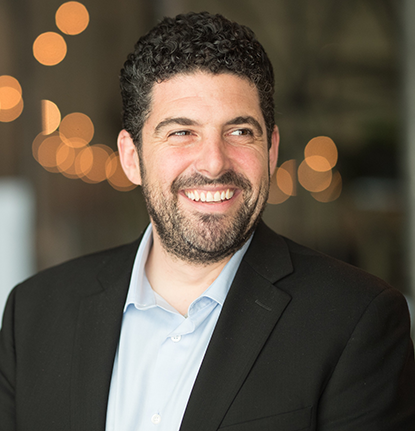
Seth Adler heads up All Things Insights & All Things Innovation. He has spent his career bringing people together around content. He has a dynamic background producing events, podcasts, video, and the written word.
View all posts















